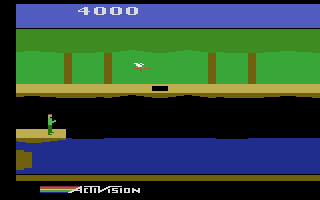Back in 2013, David Crane chimed in on a thread about Pitfall II. The Atari VCS (a.k.a. 2600) was not known for the quality of its music. For sound effects, especially noise effects like blasts and booms, it was fine, but its TIA chip didn’t have the frequency resolution to produce every musical note precisely, meaning some of it notes would sound a bit off.
There was technically a way to produce almost arbitrary waveforms, though like many techniques on the system it was processor-intensive. It involved changing the volume on one of its sound channels in real time to simulate the waveform of the sound you wanted to make. That was fine so long as you didn’t need the processor to do anything else, and sadly, on the VCS, just displaying graphics relied heavily on the processor.

David Crane managed to get decent polyphonic music out of the VCS by using Pitfall II’s DPC chip, which Crane created himself, as a co-processor that figured out the right values to set the volume to produce the mixed waveform for the music at a specific time, which the machine’s overworked 6507 CPU could then read and send to the right volume register in the TIA every scanline. The process is explained (to the understanding of a sufficiently technical frame of mind) here. I think I understand it myself!
The fact that David Crane is still around, and so willing to discuss the many tricks he came up with to make his games, is a great blessing, as is the existence of the AtariAge forums themselves, which are a trove of classic gaming information.
Nowadays this technique has been refined and utilized in homebrew cartridge productions. A particular standout is the music from Champ Games’ version of Mappy, which is frankly amazing. Check it out:

The story with Mappy is little complicated. It goes beyond what the DPC chip is capable of. Originally, the Harmony SD flash cartridge implemented an ARM-emulated DPC to allow homebrew to utilize it. Then the DPC emulator was extended with new capabilities and called DPC+. The DPC+ allows larger ROMs, more flexible banking, and enables faster TIA displays. DPC+ also has “kernel” mode that basically unlocks the ARM processor for general usage and allows the game logic to run on the ARM instead of the Atari 2600’s native CPU. DPC+ Kernel is still limited by the TIA’s 76-cycle scanline but it allows for some incredible things. The Harmony DPC+ technology is available on a Melody PCB intended as single, stand-alone games, and that’s what you’ll find inside a Mappy cartridge.
This is the kind of comment that makes it a joy to write for Set Side B!